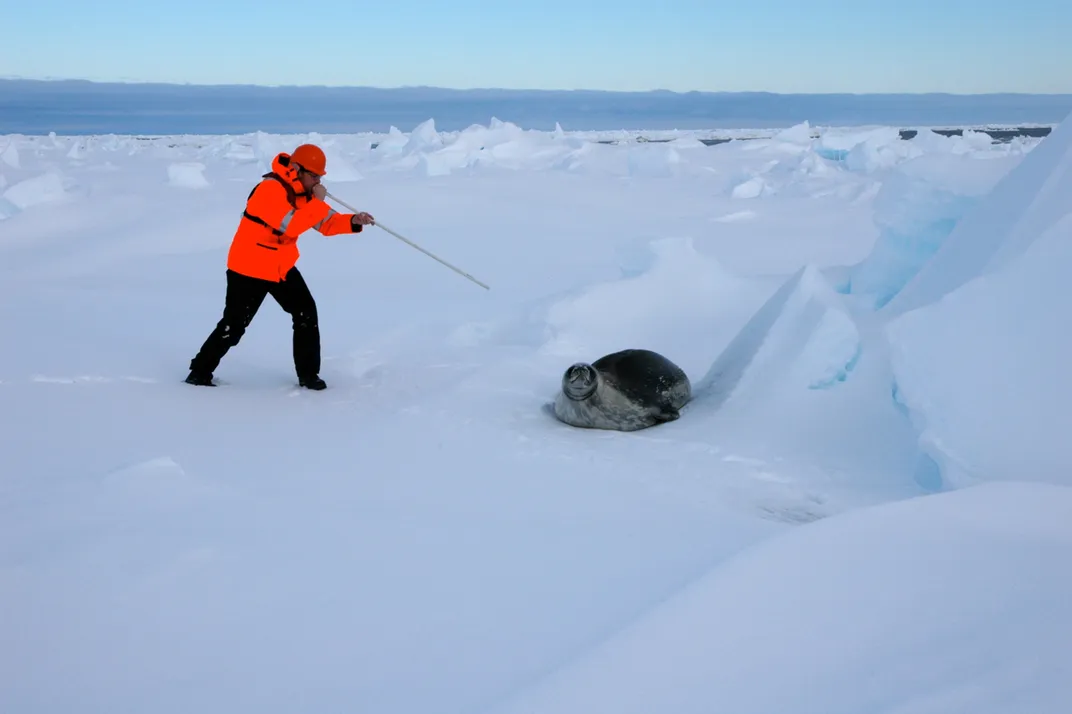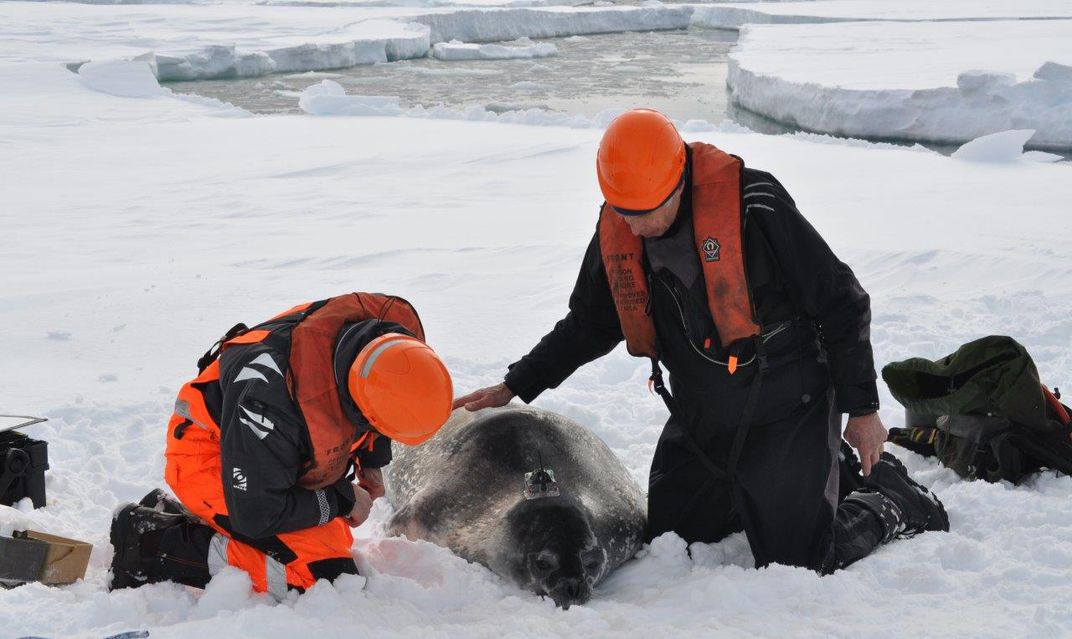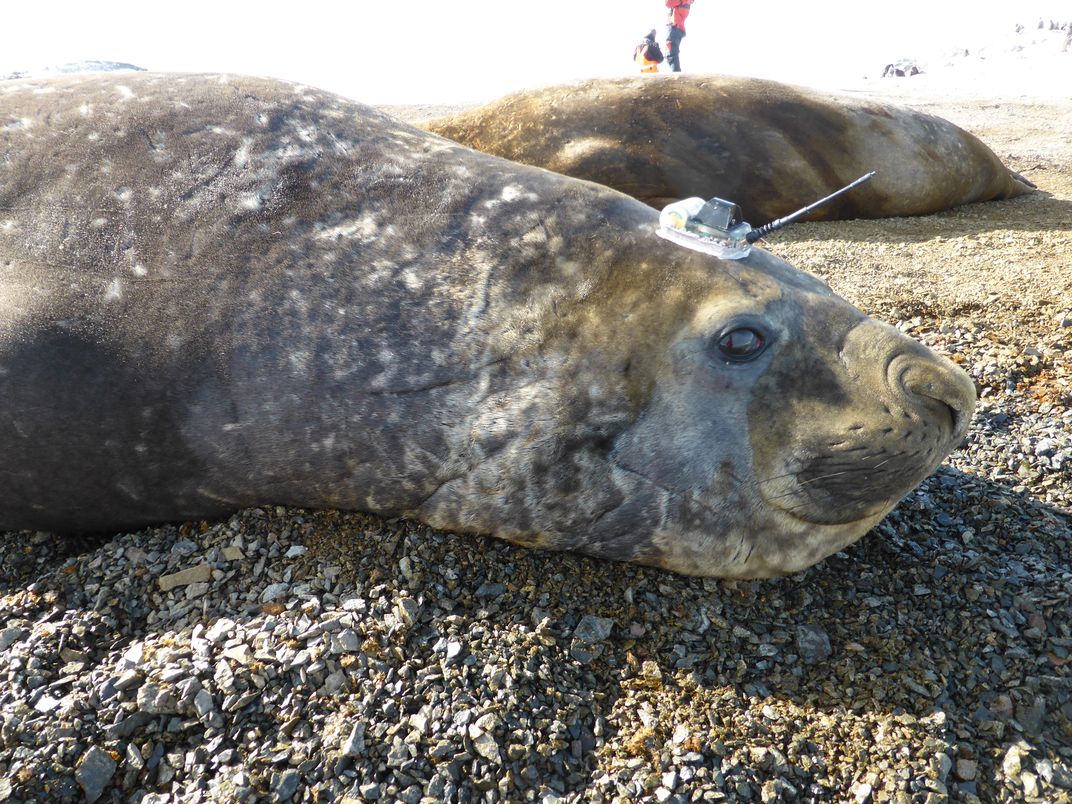How Data-Gathering Seals Help Scientists Measure the Melting Antarctic
Stumped on how to take the temperature of the ocean floor, oceanographers turned to the cutest, most competent divers they knew
/https://tf-cmsv2-smithsonianmag-media.s3.amazonaws.com/filer/b9/d9/b9d9e780-29b7-4c92-aa06-3f0e11d4f256/weddellcrop.jpg)
Brice Loose can tell you exactly what an elephant seal feels like: a furry inflatable squishy toy, not quite as hard as a basketball. He can tell you how the large sausages undergo a not-so-pleasant annual “catastrophic molting” in which they appear to be literally falling apart as they shed their brown hairy skin to make room for the new fur. He can even tell you how awful elephant seal feces smell.
“You get in there and everything smells like poo, but you get down to business,” recalls Loose, an oceanographer who is tagging seals for his first time in western Antarctica near Pine Island Glacier, the fastest shrinking glacier in the world. Over the past 15 years, the glacier has thinned at a rate of more than one meter per year, draining an area two-thirds the size of the United Kingdom.
In 2014, Loose was part of a team to help tag elephant (Mirounga leonina) and Weddell seals (Leptonychotes weddellii) for a study. The seals weren’t the subjects of the study, though—they were its research assistants. Loose was helping fit the able divers with trackers so that they could collect data on the Amundsen Sea’s temperature and salinity at great depths, which would provide clues into the mechanism of the rapid ice melt in Antarctica. The research was published in Geophysical Research Letters in May 2018.
Currently, scientists theorize that Antarctic melting is partially caused by a warmer, saltier current beneath the ice known as the “circumpolar deep water.” These waters, which are present at depths of 400 meters, are brought to the surface and lick the underside of ice sheets, melting them and enabling sea levels to rise.
“In Pine Island Bay, this is particularly important,” says Helen Mallett, the lead author of the study and a postgraduate researcher at the University of East Anglia in the United Kingdom. “The circumpolar deep water there is melting the unstable, fast thinning Pine Island Glacier, which in turn drains the vulnerable and massive West Antarctic Ice Sheet.” If all the unstable ice in west Antarctica melts, sea levels could rise by up to 10.5 feet globally.
Scientists know the warm current exists in the Amundsen Sea, but they need to know more. To get a complete picture, scientists need to answer some basic questions: Where are the warm waters, exactly? How thick is the layer of warm water ? How does it vary from winter to summer?
For this, they turned to the enormous marine mammals with large puppy dog eyes.

Seals are known for their impressive diving skills, with some species torpedoing down to depths of 2,000 feet even in sub-zero temperatures. These skills made them the perfect partners for collecting temperature data at the seafloor. Researchers had not collected any winter data in this region because the conditions are too harsh for humans.
“We could see that seals dive at these extreme depths and go these vast distances,” says Mike Fedak, a seal biologist at the University of St. Andrews in the UK who has been tagging animals for the past 39 years. “These animals go where we can’t.”
But first, they needed to equip the seals. Tagging seals is not Mallett’s field of expertise, so she collaborated with Fedak and his colleagues at the Sea Mammal Research Unit at St. Andrews. With funding from the Natural Environment Research Council’s Ice Sheet Stability Research Programme, the team headed down to Pine Island Glacier region to begin tagging in February 2014.
Under Fedak’s guidance, the team first eyeballed seals from far away, then approached them until they were just feet from the animals. Next, they sedated one by spitting out a blow dart filled with a common carnivore sedative, and lifted the 2-ton seal to measure its size and weight.
The researchers brushed off excess hair around the seal’s brow, lathered on epoxy glue, and mount a Conductivity-Temperature Depth Satellite Relay Data Logger— a sensor with a skinny antennae protruding, making it appear as if the seal had a horn. Researchers hoped the device would stay on until the following year, when the seal would dispose of it in its annual molting. Until then, the seals would be swimming around in what looks like a makeshift unicorn costume.
In total, Fedak and the crew tagged seven elephant seals found on dry beaches near Pine Island. Two weeks later, they set out again to tag seven additional Weddell seals, which are ice-loving in contrast to the beach-lounging elephant seals. In addition, whereas elephant seals like diving in open water, Weddell seals dive in front of glaciers and are known for their ability to approach the bottom of the ocean floor.

Tagging the Weddell seals was quite different from tagging the elephant seals. In much blustery conditions than the beach-loving elephant seals, the crew found one seal alone on a floating ice sheet. The Weddell seals were already finished molting, so the scene was much cleaner. The fur of Weddell seals appeared like beautiful patchwork, speckled with splotches of grey on dark-silver skin. The seals’ snowy coats seemed almost luminescent.
Fedak and the crew pulled up by the seal in a bright red, 7,000-ton ship that rumbled the ground—not exactly subtle. Fedak said, if he were a seal, he would probably make a break for the water and escape the commotion. But this seal didn’t. Why not? Weddell seals have no land-based predators, as its two main predators are leopard seals and killer whales. Even if the seal feels endangered on land, it will hesitate before entering water where there is a known threat.
“There’s definitely something special about interacting with animals that close,” says Loose. “The elephant seals were more standoffish, but the Weddell seals were so endearing.”
In approximately nine months when the sensors fell off, the elephant and Weddell seals collected more summer and wintertime ocean data in this area of the Amundsen Sea than researchers had ever had before. The seals captured data over 11,307 dives, of which 6,704 provided useful temperature data. By contrast, previous measurements made from ships only gave around 1,000 data sets over the past two decades.
The study showed that the layer of warmer circumpolar deep water was thicker in the winter, and thus contained more heat and salt than during the summer months. This suggests that the circumpolar deep water may melt more ice in winter that in summer. This is intriguing, says Mallett, because it’s in contrast to what researchers have seen west of the Amundsen Sea.
“Having observed these seasonal changes, we can look into the physical mechanisms of how the warm water travels in the area,” says Yoshi Nakayama, an oceanographer at NASA’s Jet Propulsion Laboratory who was not involved in the study. “We have to understand the processes, and having data is the first step.”

Of course, there are risks to using this unorthodox strategy. Once, Loose and a few others were dragged by a not-fully-sedated elephant seal trying to make a break for the water. Fedak shouted orders, and the men were able to redirect the seal, which eventually calmed down as the sedative kicked in. Even when a seal is sedated though, the crew must remain alert as they are surrounded by fully awake, burly seals.
In the early 2000s, the idea of using sea mammals as ocean observers seemed laughable. Fedak recalls that when he first brought up the idea to a group of oceanographers at a conference in the early 2000s. He had just been successful at attaching similar temperature sensors to beluga whales—“seals are much easier to work with than beluga whales, I can assure you,” he says—but the oceanographers weren't convinced.
“I was laughed at when I was first suggested it to an oceanographic meeting in London,” says Fedak. “I was trying to sell them on using hooded seals in the North Atlantic to understand the Gulf Stream behavior and they were putting out expensive buoys to measure it … They just laughed, literally.”
They’re no longer laughing. This study is the first time that researchers have used data-collecting seals in this region of the Southern Ocean, but many others have begun using seals to collect ocean data—as well as whales and orcas. A group of international researchers even created an open database system that shares animal-derived data on oceans called Marine Mammals Exploring the Oceans Pole to Pole. The database contains over 500,00 freely available ocean data collected by sea mammals. “That was a dream to get this data in the hands of many people,” said Fedak.
Fedak will continue to add to the database, tagging the furry mammals to collect data for the oceanographic community for many years to come. In other words, his fate is pretty much sealed.